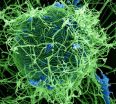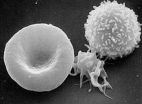(Press-News.org) Researchers from the Copenhagen Center for Glycomics at the University of Copenhagen have studied an important receptor protein called LDLR using new, groundbreaking techniques. The protein plays an important role in the absorption of the bad cholesterol, LDL.
The findings have just been published in the Journal of Biological Chemistry.
The key to major discoveries within the fields of health and diseases is not just hidden in the human DNA code. The proteins encoded by the genes also play an important role, not least the attached sugar chains which give the proteins an identity and handle important functions in the human organism. Researchers have now studied how LDLR is decorated with sugar molecules, so-called glycosylation modifications.
- We have not previously had a simple method for studying where glycosylation modifications are located on proteins in the body, because the sugars are very complicated and appear in different combinations. By removing the Cosmc protein, which is necessary for extending the sugar modifications, we have created cells with simplified glycosylations, which we call SimpleCells. The technique has enabled us to see 20 times as many sugar modifications on our proteins as were previously known, says PhD Nis Borbye Pedersen, formerly postdoc at the Copenhagen Center for Glycomics, now postdoc at the Department of Biology, University of Copenhagen.
A surprising finding
An interesting finding of the study, characterised as a regular breakthrough by Nis Borbye Pedersen, is the discovery of which of the 20 almost identical enzymes is responsible for the so-called O-glycosylation, where the GalNAc sugar molecule is bound to the amino acids serine and threonine.
- So far, we have not really understood why the body has produced 20 more or less identical enzymes. We have now found out that only one of them seems to be involved in precisely these sugar modifications: GalNAc-T11. So the study provides us with an understanding of which tasks the 20 enzymes perform, he says.
Sugar the key to cholesterol
The researchers from the Copenhagen Center for Glycomics are now conducting new studies which indicate that the presence or not of sugar modifications on the receptor protein LDLR does have a functional impact. The new results may play a role in the future treatment of cholesterol.
- We are currently studying whether glycosylation affects the receptor protein's ability to bind and remove cholesterol from the blood. It has long been known that the receptor protein LDLR plays a key role, at the molecular level, to getting rid of the bad cholesterol and thus improving our health, and so understanding the regulation of this important receptor protein is very valuable. At best, it may improve the strategy for treating high blood cholesterol levels, says Nis Borbye Pedersen.
INFORMATION:
Read the article in the Journal of Biological Chemistry
Sugar is the new black
The Copenhagen Center for Glycomics is a basic research centre at the University of Copenhagen that wants to break the biochemical code of sugars.
New technology offers insight into cholesterol
2014-08-14
ELSE PRESS RELEASES FROM THIS DATE:
Study details shortage of replication in education research
2014-08-14
WASHINGTON, D.C., August 14, 2014 – Although replicating important findings is essential for helping education research improve its usefulness to policymakers and practitioners, less than one percent of the articles published in the top education research journals are replication studies, according to new research published today in Educational Researcher (ER), a peer-reviewed journal of the American Educational Research Association.
"Facts Are More Important Than Novelty: Replication in the Education Sciences," by Matthew C. Makel of Duke University and Jonathan A. ...
PTSD can develop even without memory of the trauma
2014-08-14
Philadelphia, PA, August 14, 2014 – There are many forms of memory and only some of these may be critical for the development of posttraumatic stress disorder (PTSD), reports a new study by researchers at the University at Albany and the University of California Los Angeles. Their findings, published in the current issue of Biological Psychiatry, suggest that even with no explicit memory of an early childhood trauma, symptoms of PTSD can still develop in adulthood.
There are case reports of people who have experienced terrible life events that resulted in brain damage, ...
New Irish research sheds light on how aspirin works to reduce cancer deaths
2014-08-14
Researchers have discovered that women who had been prescribed aspirin regularly before being diagnosed with breast cancer are less likely to have cancer that spread to the lymph-nodes than women who were not on prescription aspirin. These women are also less likely to die from their breast cancer.
The study of Irish patients funded by the Irish Health Research Board and Irish Cancer Society and published by the American Association for Cancer Research in the Journal, Cancer Research, analyses records from the National Cancer Registry Ireland (NCRI), and prescription ...
New non-invasive technique controls size of molecules penetrating the blood-brain barrier
2014-08-14
New York, NY—August 14, 2014—A new technique developed by Elisa Konofagou, associate professor of biomedical engineering and radiology at Columbia Engineering, has demonstrated for the first time that the size of molecules penetrating the blood-brain barrier (BBB) can be controlled using acoustic pressure—the pressure of an ultrasound beam—to let specific molecules through. The study was published in the July issue of the Journal of Cerebral Blood Flow & Metabolism.
"This is an important breakthrough in getting drugs delivered to specific parts of the brain precisely, ...
Workaholism: The addiction of this century
2014-08-14
In spite of the many positive aspects of work, some people are unable to detach from it – working excessively and compulsively. These are called workaholics.
Postdoctoral Fellow Cecilie Schou Andreassen and colleagues from the Department of Psychosocial Science at the University of Bergen (UiB) in Norway has been the first to assess workaholism in a nationally representative sample.
According to Schou Andreassen, the "workaholism" concept has been studied by scholars for nearly 45 years. Still, reliable statistics on the prevalence of workaholism is hard to find. The ...
EARTH Magazine: La Brea climate adaptation as different as cats and dogs
2014-08-14
Alexandria, Va. — The La Brea tar pits in downtown Los Angeles are a famous predator trap. For every herbivore, a dozen or more carnivores — saber-toothed cats and dire wolves chief among them — are pulled from the prolific Pleistocene fossil site. In fact, the remains of more than 4,000 dire wolves have been excavated, along with more than 2,000 saber-toothed cats. The sheer number of fossils allows researchers to ask population-level questions about the climate and environment as well as how these animals evolved.
Now, two new studies focusing dire wolves and saber-toothed ...
Ebola outbreak highlights global disparities in health-care resources
2014-08-14
The outbreak of Ebola virus disease that has claimed more than 1,000 lives in West Africa this year poses a serious, ongoing threat to that region: the spread to capital cities and Nigeria—Africa's most populous nation—presents new challenges for healthcare professionals. The situation has garnered significant attention and fear around the world, but proven public health measures and sharpened clinical vigilance will contain the epidemic and thwart a global spread, according to a new commentary by Anthony S. Fauci, M.D., director of the National Institute of Allergy and ...
New blood: Tracing the beginnings of hematopoietic stem cells
2014-08-14
Hematopoietic stem cells (HSCs) give rise to all other blood cell types, but their development and how their fate is determined has long remained a mystery. In a paper published online this week in Nature, researchers at the University of California, San Diego School of Medicine elaborate upon a crucial signaling pathway and the role of key proteins, which may help clear the way to generate HSCs from human pluripotent precursors, similar to advances with other kinds of tissue stem cells.
Principal investigator David Traver, PhD, professor in the Department of Cellular ...
Novel chip-based platform could simplify measurements of single molecules
2014-08-14
Researchers at UC Santa Cruz have developed a new approach for studying single molecules and nanoparticles by combining electrical and optical measurements on an integrated chip-based platform. In a paper published July 9 in Nano Letters, the researchers reported using the device to distinguish viruses from similarly-sized nanoparticles with 100 percent fidelity.
Combining electrical and optical measurements on a single chip provides more information than either technique alone, said corresponding author Holger Schmidt, the Kapany Professor of Optoelectronics in the Baskin ...
Stem cells in the skeletal muscle promote the regeneration of severe nerve peripheral injury
2014-08-14
A research group at the muscle physiology and cell biology unit, the Tokai University School of Medicine, Japan, led by Dr. Tetsuro Tamaki, have developed the stem cell isolation method from the skeletal muscle, termed skeletal muscle-derived multipotent stem cells (Sk-MSCs), which can differentiate into Schwann and perineurial/endoneurial cells, and vascular relating pericytes, endothelial and smooth muscle cells in the damaged peripheral nerve niche. Application of the Sk-MSCs in the bridging conduit of the long nerve gap injury resulted favorable axonal regeneration ...


